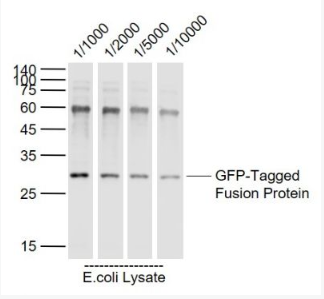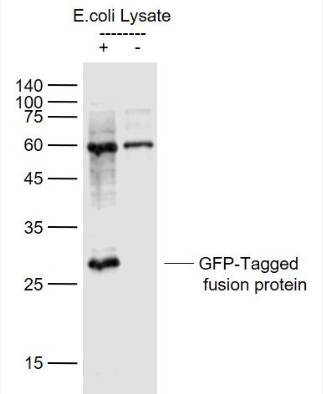
货号
产品规格
售价
备注
BN42208R-50ul
50ul
¥900.00
交叉反应(总):Recombinant protein;推荐应用:WB IF
BN42208R-100ul
100ul
¥1200.00
交叉反应(总):Recombinant protein;推荐应用:WB IF
BN42208R-200ul
200ul
¥2000.00
交叉反应(总):Recombinant protein;推荐应用:WB IF
产品类型 | 标签抗体 |
研究领域 | 细胞生物学 免疫学 |
抗体来源 | Rabbit |
克隆类型 | Polyclonal |
交叉反应 | Recombinant protein |
产品应用 | WB=1:20000-50000 IF=1:100-500 |
分 子 量 | 27kDa |
性 状 | Liquid |
浓 度 | 1mg/ml |
免 疫 原 | KLH conjugated synthetic peptide derived from belt jellyfish GFP:151-238/238 |
亚 型 | IgG |
纯化方法 | affinity purified by Protein A |
储 存 液 | 0.01M TBS(pH7.4) with 1% BSA, 0.03% Proclin300 and 50% Glycerol. |
保存条件 | Shipped at 4℃. Store at -20 °C for one year. Avoid repeated freeze/thaw cycles. |
PubMed | PubMed |
产品介绍
Green fluorescence protein (GFP) is a 27 kDa protein derived from the jellyfish Aequorea victoria, which emits green light (emission peak at a wavelenth of 509 nm) when excited by blue light (excitation peak at a wavelenth of 395 nm). Green Fluorescent Protein (GFP) has become an invaluable tool in cell biology research, since its intrinsic fluorescence can be visualized in living cells. GFP fluorescence is stable under fixation conditions and suitable for a variety of applications. GFP has been widely used as a reporter for gene expression, enabling researchers to visualize and localize GFP-tagged proteins within living cells without the need for chemical staining. Other applications of GFP include assessment of protein protein interactions through the yeast two hybrid system and measurement of distance between proteins through fluorescence energy transfer (FRET) protocols. GFP technnology has considerably contributed to a greater understanding of cellular physiology.
Function:
Energy-transfer acceptor. Its role is to transduce the blue chemiluminescence of the protein aequorin into green fluorescent light by energy transfer. Fluoresces in vivo upon receiving energy from the Ca(2+)-activated photoprotein aequorin.
Subunit:
Monomer.
Tissue Specificity:
Photocytes.
Post-translational modifications:
Contains a chromophore consisting of modified amino acid residues. The chromophore is formed by autocatalytic backbone condensation between Ser-65 and Gly-67, and oxidation of Tyr-66 to didehydrotyrosine. Maturation of the chromophore requires nothing other than molecular oxygen.
Important Note:
This product as supplied is intended for research use only, not for use in human, therapeutic or diagnostic applications.
该抗体只用于免疫组织化学、免疫荧光、酶联免疫使用。
GFP在科学研究上有着惊人的用途,因为它能够使我们直接看到细胞内部的运动。情况。在任何指定的时间我们都可以轻易地找出GFP在哪儿:你只需要用紫外光去照射,这时所有的GFP都将发出鲜艳的绿色。
不妨做个实验:你把GFP连接到你有兴趣观察的任何对象上。比如,你可以把它连接到一种病毒上。然后,随着病毒在宿主体内不断扩散,你就可以通过跟踪发出的绿光来观察病毒的扩散途径;或者你把它接合到一种蛋白质上并通过显微镜观察它在细胞内部的移动。
GFP是一种现成的荧光蛋白质,因此它特别容易使用。大多数可以处理光的蛋白质都利用外来的分子吸收和释放光子。例如,我们眼睛里的视紫红质利用维生素来感光。这些“发光团”必须是专门为了发光而生成的,并且被仔细地插入到该蛋白质分子内,不同的是,GFP控制光的部位是其自身的一部分,仅由氨基酸构建而成,该部位含有一段三个氨基酸组成的特殊序列:丝氨酸 Ser-酪氨酸Tyr-甘氨酸 Gly(有时丝氨酸会被相似的苏氨酸取代)。当蛋白质链折叠时,这段短片段就被深埋在蛋白质内部,然后,发生一系列化学反应:甘氨酸与丝氨酸之间形成化学键,生成一个新的闭合环,随后这个环会自动脱水。最终,经过大约一个小时的反应,周围环境中的的氧气攻击酪氨酸的一个化学键,形成一个新的双键并合成荧光发色团。由于GFP可以形成自己的发色团,它非常适合于基因工程。你根本不必担心操作任何奇怪的发色团,你只需要利用遗传学的方法操纵细胞合成GFP蛋白质,GFP就会自动折叠并开始发光。
GFP的用途已经扩展到艺术和商务领域,育种工作者正在探索利用GFP来创造特殊的荧光植物和各种鱼类,GFP已经被移植到大鼠、老鼠、青蛙、有翅昆虫、蠕虫以及不计其数的其它生物体内。
产品图片



